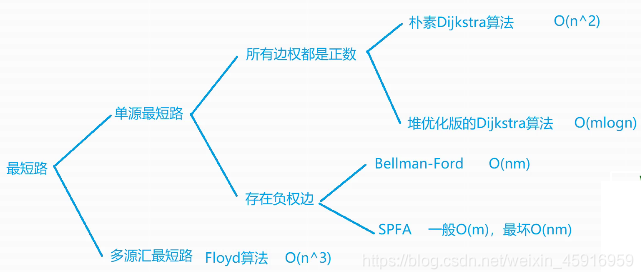Dijkstra 學習心得 20.8.13
2020-08-13 21:06:28
最短路

樸素Dijkstra
1、思路
*0、定義陣列 dis[n] (從1到其它點的距離), s[n](已經確定最短距離的點);
*1、初始化 dis[1] = 0, dis[其它點] = 正無窮;
*2、 for(1 ~ n);——————————回圈 n 次,更新所有的點 t;
*3 找到 不在s中的,距離最近的點 t;
*4 將t加入s;
*5 用t更新其它點的距離;————————回圈n次
(這裏是兩 層 回圈, 所以時間複雜度是 n^2)
*6 返回
例題
#include<bits/stdc++.h>
using namespace std;
const int N = 510;
int n, m;
int g[N][N];
int djs[N];
bool s[N];
int djst(){
memset(djs, 0x3f3f3f3f, sizeof djs);/* *1 */
djs[1] = 0; /* *1 */
for(int i = 0; i < n; i ++){ /* *2 */
int t = -1; /* *3 */
for(int j = 1; j <= n; j ++) /* *3 */
if(!s[j] && (t == -1 || djs[t] > djs[j])) /* *3 */
t = j; /* *3 */
s[t] = 1; /* *4 */
for(int j = 1; j <= n; j ++) /* *5 */
djs[j] = min(djs[j], djs[t] + g[t][j]); /* *5 */
}
if(djs[n] == 0x3f3f3f3f) return -1; /* *6 */
return djs[n]; /* *6 */
}
int main(){
cin >> n >> m;
memset(g, 0x3f3f3f3f, sizeof g);
while(m --){
int a, b, c;
cin >> a >>b >>c;
g[a][b] = min(g[a][b], c);
}
int t = djst();
cout << t;
return 0;
}
/*
0x3f3f3f3f 代表 正無窮。
*/
優化Dijkstra :
可以更新的地方:
分析:
*2、 for(1 ~ n);·;
*3 找到 不在s中的,距離最近的點 t;——————*2、*3共回圈 n^2 次來找點 t;(用堆來做可時間O(n))
*4 將t加入s;——————————————————這裏是n次
*5 用t更新其它點的距離;—————————————具體操作時m次嗎,遍歷所有的邊來更新
堆優化後 整個計算量最大是 O(m log n)。
堆的寫法:
手寫或用優先佇列,兩者時間是一個級別的,用優先佇列,不需要手寫堆。
#include<bits/stdc++.h>
using namespace std;
const int N = 150010;
int n, m;
int djs[N];
bool st[N];
int ne[N], e[N], h[N], w[N], idx = 0;
typedef pair<int ,int> P;
void add(int a, int b, int c){
e[idx] = b, w[idx] = c, ne[idx] = h[a], h[a] = idx ++;
}
int djst(){
memset(djs, 0x3f, sizeof djs);
djs[1] = 0;
priority_queue< P, vector<P>, greater<P> > heap;/* *1 */
heap.push( {0, 1} );
while(heap.size()){
auto t = heap.top();
heap.pop();
int ver = t.second, distance = t.first;
if(st[ver]) continue;
st[ver] = 1; /* *2 */
for(int i = h[ver]; i != -1; i = ne[i]){
int j = e[i];
if(djs[j] > distance + w[i]){
djs[j] = distance + w[i];
heap.push({djs[j], j});
}
}
}
if(djs[n] == 0x3f3f3f3f) return -1;
return djs[n];
}
int main(){
cin >> n >> m;
memset(h, -1, sizeof h);
while(m --){
int a, b, c;
cin >> a >>b >>c;
add(a, b, c);
}
cout << djst() << endl;
return 0;
}
給定一個n個點m條邊的有向圖,圖中可能存在重邊和自環,所有邊權均爲非負值。
請你求出1號點到n號點的最短距離,如果無法從1號點走到n號點,則輸出-1。
輸入格式
第一行包含整數n和m。
接下來m行每行包含三個整數x,y,z,表示存在一條從點x到點y的有向邊,邊長爲z。
輸出格式
輸出一個整數,表示1號點到n號點的最短距離。
如果路徑不存在,則輸出-1。
數據範圍
1≤n,m≤1.5×105,
圖中涉及邊長均不小於0,且不超過10000。
輸入樣例:
3 3
1 2 2
2 3 1
1 3 4
輸出樣例:
3
*1 強調:「>」不要兩個拼在一起。
less是從大到小,greater是從小到大。
第一個參數爲數據型別。
第二個參數爲容器型別。
第三個參數爲比較函數。
*2 千萬不要忘記。